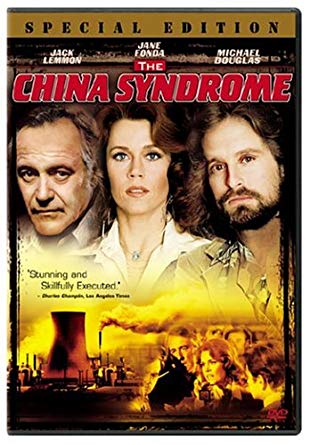The China Syndrome ___ 10/10
Precautionary, thrilling Hollywood tale
Written by Mike Gray and T.S. Cook
Directed by James Bridges
Jane Fonda … Kimberly Wells
Jack Lemmon … Jack Godell
Michael Douglas … Richard Adams
Wilford Brimley … Ted Spindler
Trying to stay with sort of a weekly theme, I cast about for environmental movies outside of Al Gore’s documentary. During my read of the book for this week, The Weather Makers, I discovered a few notable scientists—chiefly James Lovelock (author of the Gaia concept)—argue for nuclear energy as a the only realistic means for escaping the global warming conundrum.
Needless to say, Lovelock has many critics. Certainly his nuke hypothesis is reasonable, especially with the advent of fail-safe pebble-bed reactors. But I think most environmentalists see renewables (solar, wind) and other methods (biomass) as fully capable of replacing carbon-intensive sources.
At any rate, one movie that offers a warning, at least on the current “fail-deadly” technology of nuclear power, while at the same time providing top-notch entertainment value is The China Syndrome. In a profound case of life imitating art, the Three Mile Island partial core meltdown occurred 12 days after the US release date (March 16, 1979).[1]
The plot centers around Kimberly Wells (a very young, and hot Jane Fonda) an LA TV news reporter, who feels stuck doing ridiculous human-interest fare. In her features capacity, she gets a chance to travel to the (fictional) Ventana Nuclear Power Plant to perform what amounts to a puff piece on local atomic energy.
While she’s there with her angry, young antiestablishment cameraman Richard Adams (Michael Douglas), an incident occurs as a consequence of a minor earthquake. They look around the control room and see men in a state of agitation and even panic. Adams secretly films the out-of-control-room scene.
Kimberly recognizes she has a story, but her bosses at the station are pressured by corporate interests to suppress the info. (A new plant is scheduled for completion, and they want nothing to interfere with the profit scenario.) She persists.
At first shift supervisor Jack Godell (Jack Lemmon) is reluctant to speak with Kimberly because he’s a widower whose whole life now is his job. Godell reveals that after the initial shock of the earthquake another noise or tremor occurred that he believes may have been generated within the plant. He begins to investigate and finds evidence of quality problems of grave concern.
As Godell seeks to make his findings known through his chain of command he grows increasingly upset that he, a ‘true believer’ in nuclear energy, cannot get someone to fix what could amount to a catastrophic failure (the China Syndrome). He’s increasingly ostracized; the corporate goons come down on him, too.[2] Finally, he turns to Kimberly to help him get the truth out in a very dramatic fashion.
This movie is a totally satisfying thriller from beginning to end, with a valid message: humans are fallible, human systems are fallible, and some humans are willing to harm innocent people through catastrophe and aggression. The same can be said for ‘legal persons’ of corporations… not that governments have much of a track record either.
Note: my book review for the week of this first reposting 7/12/18 is of the John Fuller investigation, producing his dramatic book We Almost Lost Detroit (1974). The derivative, yet ironclad proof that conventional nuclear power is unsafe—true for any product or technology the toxocracy wishes to foist upon the general public: vaccines, 5G wireless cellular, ‘smart’ meters, GMOs, contaminant spraying and heating of the atmosphere, oil spills, fracking, etc.—is nobody will insure it.
In the case of nuclear fission plants, the federal government imposed the Price-Anderson Act limiting liability for any nuclear accident to some artificially low number ($560 million) most of which the taxpayers would have to cough up, anyway. [Per Fuller, the Brookhaven studies of the mid 1960s showed that a full-scale meltdown that nearly occurred (October 5, 1966) at the Monroe, Michigan, Fermi plant could produce 27,000 deaths, 73,000 injuries, and $17 billion in property damage in the near term. Radioactive byproducts would continue to contaminate tens of thousands of square miles for hundreds of years.]
When you consider all the fallibilities and potential for malice, I think I’d rather build a windmill. Lemmon and Fonda each received Oscar nominations; the film won several awards worldwide. Not bad for a movie that makes you think.
[1] Later, in April of 1986, the Chernobyl nuclear plant in Ukraine suffered an explosion that released poisonous radioactive waste over a large area. The official death count is 56, but a 2005 World Health Organization report says as many as 9,000 people will die from radiation related to the incident. Some claim the number is much higher, especially considering the water and other resources contaminated.
[2] Before The China Syndrome was released, Karen Silkwood, a worker for Kerr-McGee who was trying to report on plutonium processing contamination, died under mysterious circumstances. Another excellent expose movie is Silkwood, starring Meryl Streep, Kurt Russell, and Cher.
This post has been read 1513 times!


